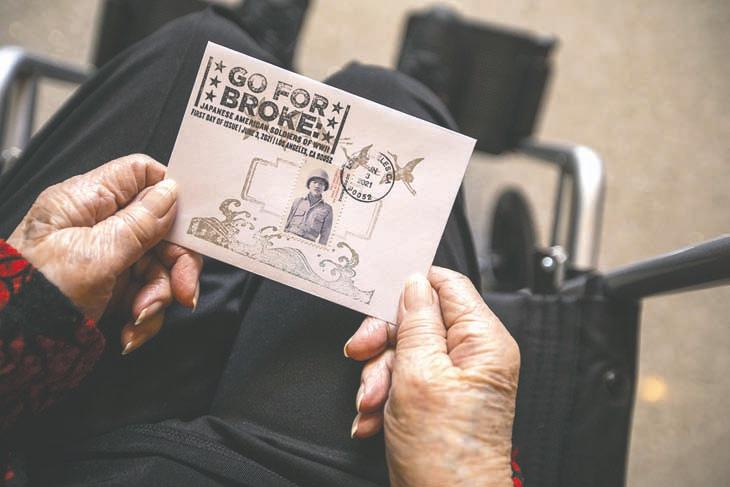
6 minute read
KRON 4 News at
the following year.
They collected endorsements from lawmakers, governors and mayors. They won support from people in the areas of France liberated by the “Go For Broke” troops.
They sent the U.S. Postal Service 10,000 handwritten signatures and 10,000 online signatures.
In 2009, postal officials told them that stamps were not allowed to honor individual military units.
Years of silence ensued, until last November, when the Postal Service announced the “Go For Broke” stamp, along with stamps honoring Missouri statehood and the nuclear physicist Chien-Shiung Wu.
Takahashi and King are now in their 90s. Ohira died during the campaign’s 15-year length.
In a statement, U.S. Postal Service officials said they are “proud to honor the bravery and sacrifice of Japanese American soldiers during World War II. They lived up to their motto with legendary acts of heroism,” and their “spirit and perseverance continue to live on in generations of Japanese Americans ever since.”
To Yoshio Nakamura, an ammunition carrier in the 442nd, the stamp’s debut is timely, considering the rise in anti-Asian attacks during the Covid-19 pandemic.
“Not everyone knows of the Japanese effort in the war, when actually, we have helped the U.S. so much through the years,” said the Whittier resident, 95, who received a Bronze Star.
Kerri Krueger, Fusa Takahashi’s granddaughter, said her grandmother taught her to be proud of her heritage and to know what Japanese Americans have suffered and overcome.
Her grandfather, Kazuo Takahashi, was drafted into the U.S. Army from a Utah prison camp in 1943. He joined the Military Intelligence Service, which employed Japanese Americans as translators to pore through documents, interrogate prisoners and intercept messages from the Japanese military.
“She wants the generations to try to understand what Asian Americans have been through, how they have progressed so far,” Krueger, 32, said of her grandmother.
The 55-cent stamp, designed by Antonio Alcalá, will always be good for up to one ounce of first-class mail.
Lynn Franklin, the Takahashis’ daughter, said the stamp represents
Francine Orr/Los Angeles Times/TNS file Fusako “Fusa” takahashi, 93, of Granite Bay, holds an envelope with the new U.S. Postal stamp “Go For Broke” at the Japanese american national Museum in Los angeles, June 4.
“how much my father and all the men and women were Americans, in every sense, and how they were willing to give up everything for America.”
At the same time, many of the soldiers were fluent in Japanese and understood Japanese culture – a tremendous advantage for the American side in the Pacific theater.
Kazuo Takahashi, who died in 1977, rarely spoke about the war. But his wife always remembered what he did and wanted the world to know about it.
“These people translated millions of documents. They did a lot of counterintelligence. They showed their patriotism at every turn,” Franklin said. “That’s why my mom refused to give up in the struggle to get a stamp. . . . She intended to showcase courage.”
attacks
From Page A3
face, licks its lips, has its ears back or yawns while walking down the sidewalk may be exhibiting stress. She also warns pedestrians to be vigilant for “whale eyes,” when the whites of the dog’s eyes are visible.
An animal looking to engage may harden its muscles, lower its head and stare directly at its target.
If a dog moves toward me, what should I do?
A dog pursuing prey follows a certain pattern: Focus, stalk, chase, acquire. If the dog isn’t tracking you, Miller said, be still and let it move past you. “If you start to run, you’re likely to become the thing that’s chased. Those are innate behaviors.”
But if a dog is tracking you, she said, get out of its way – slowly. If you must move past the animal, Miller said, move away on a diagonal, at walking speed, to create the most distance as quickly as possible.
“Moving in a diagonal turns your body sideways. It says, I’m not a threat to you. It’s really to get out of the dog’s direct line of sight,” she said.
If the situation is really bad, it might be useful to step inside a gate at a home without a dog. Look out for pickup trucks with an open bed you can climb into, or place your child in, or a car you could get on top of, Miller said. Once, when a stray menaced a small dog she was walking, she put it in a garbage can.
If moving away from the dog or breaking its line of sight is not possible, Miller said, remember: “Stand like a tree, don’t flee,” with arms straight at your side, or crossed over your chest. “Sometimes that dog will run right up to you and sniff you, and then move along – and it’s terrifying when that happens.”
What should you do if a dog bites you?
“Your instinct is to pull away, but really, you should lean in. Dogs have an oppositional instinct, which is that if (prey) pulls away, bite harder,” Miller said.
This, she acknowledged, may be hard to actually do – and harder yet for a child.
A loud, low noise may startle a dog and cause it to back off. “If there is an object that you have – a backpack, a purse, if you’re an older person with a cane – swing it back and forth low like you’re sweeping” to create space between a biting dog and yourself or your child.
It’s human instinct, Miller said, to raise an object to deliver a blow. “But when you lift up, you leave your whole body exposed.”
If a dog is lunging at you or your child, Miller said, pepper spray can work. She recommends Halt Dog Repellent. She’s also used Pet Corrector, a product that emits a hissing noise.
If you’re brought to the ground by a dog or group of dogs, Miller said, interlace your fingers and curl into a tight ball. If a dog has your child, “Hitting isn’t going to do anything,” she added.
I tell Miller that a surprising number of mothers I know are prepared to gouge an attacking dog’s eyes out.
“As a parent, if getting the dog to redirect on you is the goal, to put yourself between your child and the dog, that could work,” she said.
“Honestly, all of the preventative steps are key, because unless you have something within arm’s length like a rake or something you can put between the child and the dog . . . children are just so small.”

The pandemic has made all of this harder
Young dogs born during Covid haven’t been socialized like their older peers. But those older dogs, she said, may need a slow re-entry to social situations.
“I’m getting a lot of calls about dogs who are really fearful, engaging in fear barking or posturing at strangers,” she said.
Even walks, she said, can be overwhelming. “You need to be checking in with dog to see if what you think is exciting is good for your dog.”
How do I talk to my child about dogs?
“We don’t want children to be afraid of dogs, but at the same time we want them to have a healthy respect for how an animal communicates through paws and mouth,” Miller said.
Regular conversations – better than one big talk. It’s important to educate children about a dog’s body language, and when a dog needs space – and to set firm rules about behavior on a walk or in a park.
“Lots of little conversations,” she said. “that’s how it sinks in.”





